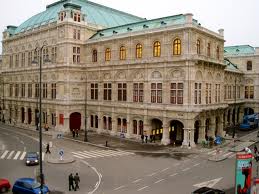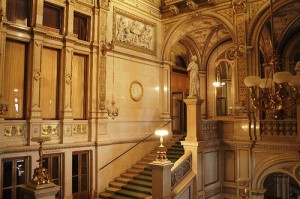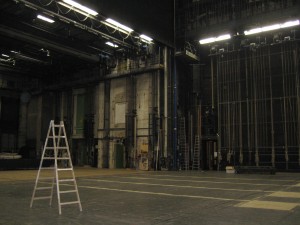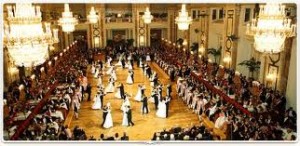For those of you just joining our story, Corzoo is a feisty, precocious, curious little fellow, who happens to be a kazoo that is shaped like a French horn. He longs to be a REAL French horn player one day and has finagled and cajoled his way into being taken along on our travels, citing that I am responsible for his development as a musician and human being.
What follows are excerpts from Corzoo’s notebook that he always carries, ready to jot down anything that catches his fancy.
My impressions, notes, and observations of the Wiener Staatsoper for future personal perusal, or (who knows?) potential use in an as-yet-unforseen treatise or scholarly article. Gathered from my brief guided tour in August of 2011.
 The Wiener Staatsoper (The Vienna State Opera) is one of the premier opera houses in the world. It is such a popular destination that there are tours in at least five languages that take place every hour! Frau Bilger and I sat in the lobby and observed everyone’s excited behavior in anticipation of the tour. Silly folks, young and old, were delighted with the grand opera costumes set up in the lobby that had face holes for snapping pictures to make it look like the person is wearing the costumes. Of course, I had no interest in such shenanigans. It helped to pass the time, though!
The Wiener Staatsoper (The Vienna State Opera) is one of the premier opera houses in the world. It is such a popular destination that there are tours in at least five languages that take place every hour! Frau Bilger and I sat in the lobby and observed everyone’s excited behavior in anticipation of the tour. Silly folks, young and old, were delighted with the grand opera costumes set up in the lobby that had face holes for snapping pictures to make it look like the person is wearing the costumes. Of course, I had no interest in such shenanigans. It helped to pass the time, though!
 The opera house opened in 1869 with a performance of Mozart’s Don Giovanni. The lobby is beautifully opulent (definition: ostentatiously rich or lavish) and is one of the areas of the original opera house. The main part of the house where the audience sits, as well as all of the stage and backstage were damaged by bombs in World War II. It took about ten years for the opera house to be repaired and reopen. The last opera to be performed before the bombs fell was Wagner’s Götterdämmerung (translation: The Twilight of the Gods). It reopened with Beethoven’s Fidelio.
The opera house opened in 1869 with a performance of Mozart’s Don Giovanni. The lobby is beautifully opulent (definition: ostentatiously rich or lavish) and is one of the areas of the original opera house. The main part of the house where the audience sits, as well as all of the stage and backstage were damaged by bombs in World War II. It took about ten years for the opera house to be repaired and reopen. The last opera to be performed before the bombs fell was Wagner’s Götterdämmerung (translation: The Twilight of the Gods). It reopened with Beethoven’s Fidelio.
 We went first backstage, which is three times the size of the area where the audience sits! Sets may be pre-assembled far backstage, underneath the stage, or even above the stage to later be moved into the scene taking place. There were no sets assembled because the opera season has not yet started; however, I believe there must be rehearsals starting somewhere because one lone baritone walked across the stage and let out a big, lusty vocal warm-up as he headed quickly to his destination somewhere in the bowels of the theater. I called after him from Frau Bilger’s bag with my Siegfried call and I was suddenly zipped inside – but not before I saw him look back with a look of amused surprise. “Ah! A young musician in the tour, eh? Sehr gut, sehr gut!” I was proud of myself for being so bold. They do have children’s operas. I shall have to see if there might be an occasion one day for me to take an audition for something like this. It’s always good to have ideas tucked away in the back of one’s mind.
We went first backstage, which is three times the size of the area where the audience sits! Sets may be pre-assembled far backstage, underneath the stage, or even above the stage to later be moved into the scene taking place. There were no sets assembled because the opera season has not yet started; however, I believe there must be rehearsals starting somewhere because one lone baritone walked across the stage and let out a big, lusty vocal warm-up as he headed quickly to his destination somewhere in the bowels of the theater. I called after him from Frau Bilger’s bag with my Siegfried call and I was suddenly zipped inside – but not before I saw him look back with a look of amused surprise. “Ah! A young musician in the tour, eh? Sehr gut, sehr gut!” I was proud of myself for being so bold. They do have children’s operas. I shall have to see if there might be an occasion one day for me to take an audition for something like this. It’s always good to have ideas tucked away in the back of one’s mind.
Next, we saw the plush interior of the hall where the audience sits. It was much smaller than I had imagined for such a famous place. There were over two thousand seats, but they went high up rather than far back, so everyone has a sense of sitting relatively close to the stage. We also visited the most exclusive first tier boxes. This is where Emperor Franz Joseph’s private box used to be. And behind it is his Imperial Tea Room where he would retreat and entertain during the intermissions. There is often more than one intermission in operas. Frau Bilger was for some reason very taken with this room. It was extravagant for sure, but not nearly as interesting as backstage in my humble opinion. That is where the true action happens! I think she likes the idea of a beautiful tea room of one’s own, which I cannot possibly understand. I would rather have a practice room of my own.
The opera house, interestingly enough, is not just for the rich and famous in Vienna to enjoy. The cheapest tickets are only €3, which is about five dollars. They are for standing room at the very tippy-top. One must not be prone to vertigo (definition: a sensation of whirling or dizziness) if one is going to purchase those tickets. The next most affordable tickets are the 5-Euro standing room tickets, and those are on the orchestra level with very good sight-lines.
 There is, however, plenty of opportunity to part with one’s money in enjoyment of the opera if one so chooses. For instance, there is the Wiener Opernball (The Vienna Opera Ball), which happens yearly. It is perhaps the grandest of balls in the world and showcases the orchestra, the singers, the choruses, and the dancers. A children’s ballet is a traditional part of the exhibition before the dancing starts. If a couple wants to be a part of the first dance, which of course is the Blue Danube by Johann Strauss (he is known as Der Walzerkönig – the King of the Waltz) they must go through a strenuous audition process, and the top couples have the honor of dancing. Then everyone is invited out on the floor to dance the evening away. It is an Event (with a Very Capital “E”) and full of over 100 years of tradition.
There is, however, plenty of opportunity to part with one’s money in enjoyment of the opera if one so chooses. For instance, there is the Wiener Opernball (The Vienna Opera Ball), which happens yearly. It is perhaps the grandest of balls in the world and showcases the orchestra, the singers, the choruses, and the dancers. A children’s ballet is a traditional part of the exhibition before the dancing starts. If a couple wants to be a part of the first dance, which of course is the Blue Danube by Johann Strauss (he is known as Der Walzerkönig – the King of the Waltz) they must go through a strenuous audition process, and the top couples have the honor of dancing. Then everyone is invited out on the floor to dance the evening away. It is an Event (with a Very Capital “E”) and full of over 100 years of tradition.
I have already decided I will make it a point to revisit Wien during the opera season so that I may attend – most likely in standing room. In the meantime, I shall have to “get my opera fix” as Frau Bilger says, with recordings. Speaking of recordings, I have discovered a recording of the Vienna Philharmonic playing Götterdämmerung. I post here now, my very favorite part:
